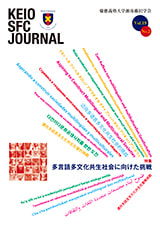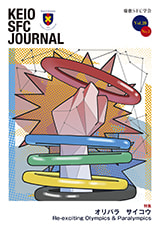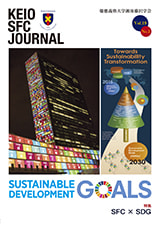- HOME
- KEIO SFC JOURNAL
- Vol.19 No.2

KEIO SFC JOURNAL Vol.19 No.2 Aspiring to Construct Multilingual and Multicultural Societies
published on 2020.03
Aspiring to Construct Multilingual and Multicultural Societies
-
[Foreword]
New Critical Multilingualism and Its Implications on Multilingual Education -Reflecting on the Initiatives and Experiences at SFC/Keio
Download this article (PDF): SFCJ19-2-00.pdfYumi Sugihara (Associate Professor, Faculty of Policy Management, Keio University) Mamoru Fujita (Assistant Professor, Faculty of Environment and Information Studies, Keio University)
-
On the Reform of Language Education -A Move to Encourage Plurilingualism in Order Not to Nurture Young People Who Are Not Good at English, But to Encourage Greater Understanding and Appreciation of Different Languages and Cultures
Fumiya Hirataka (Professor, Faculty of Policy Management, Keio University) This paper asserts that the spread of plurilingualism in Japan leads to a beneficial diversification of the views on foreign culture by Japanese and enriches Japanese society, and furthermore that plurilingual speakers who can contribute to mutual intercultural understanding can be nurtured through the following reform plan: 1) Foreign language activities at the elementary school level should not be limited to English. 2) A new subject, "Introduction to the foreign language learning" should be developed in upper secondary school. 3) Second foreign languages after English should be taught in upper secondary school. 4) A robust application of knowledge and skills of a plurality of foreign languages should be encouraged and supported in research at the university level. 5) The teaching of mother and heritage languages should become the norm in public schools.
Download this article (PDF): SFCJ19-2-01.pdf -
Language Retention Among Children Crossing Borders -A Case Study of German Saturday School Kyoto
Wakana Baba (Assistant Professor, Faculty of Policy Management, Keio University) In the course of globalization, people, goods, capital and information move more freely than ever before. Behind the adults moving across national borders are a large number of "Children Crossing Borders (CCB)" who have to accompany their parents. This paper examines the attempts to retain language proficiency of the "CCB" with special reference to the "Deutsche Samstagsschule Kyoto (German Saturday School Kyoto)" and identifies the issues to promote language learning of the "CCB" who will increase more and more in number.
Download this article (PDF): SFCJ19-2-02.pdfCurrent State of Ethnic Minority Education in China -Survey Results of Korean Minority High Schools Across Three Provinces in Northeastern China
Takeya Takagi (Assistant Professor, Faculty of Policy Management, Keio University) This paper reports on the current state of Korean minority high schools across three provinces in northeastern China. Results of the analysis found that while Korean minority schools continue to function in part as ethnic minority educational institutions, their operations have been subject to considerable influence from the Chinese education system, university entrance examination system, and other societal changes in recent years. In addition, under trends such as a declining birth rate, Han Sinicization, and population migration, school finance problems, management difficulties, and securing of teachers, etc. are becoming more prominent, which may lead, in turn, to a decline in the quality of education. In both densely and sparsely populated areas, great efforts are being undertaken in schools to overcome the current situation.
Download this article (PDF): SFCJ19-2-03.pdfDiversity of the Arabic Language in North Africa
Haruko Sakaedani (Part-time Lecturer, the Keio Institute of Cultural and Linguistic Studies, Keio University) The purpose of this paper is to present the diversity of the Arabic language, as well as the diversity of the Arabic-speaking people who live in North Africa. The Arabic-speaking society is in a state of 'diglossia'; that is, two varieties (Standard Arabic and Colloquial Arabic) of the same language are used quite differently within the speech community. Colloquial Arabic has many varieties based on speakers' characteristics such as area, literacy level, gender, and religion. The diversity of the language indicates diversity in its speakers. The Arab world is often lumped together as being only 'Muslim' or 'Arab', but many groups of people live here.
Download this article (PDF): SFCJ19-2-04-72d8976cb.pdfMoving Past Native-Speakerism in English Language Teaching (ELT) in Japan
Matikainen Tiina (Visiting Lecturer, Faculty of Environment and Information Studies, Keio University) This paper discusses the need for diversifying English Language Teaching (ELT) in Japan both by providing and empowering more realistic language user models for students as well as using materials that more closely reflect the current status of English in the world. Japanese ELT field continues to operate under the native speaker fallacy principle which in turn creates a native speaker learner fallacy for students which hinders students' language learning progress. This paper also suggests practical and pedagogical ways to move past native-speakerism in Japanese higher education English classrooms.
Download this article (PDF): SFCJ19-2-05-7b77a194.pdfToward Inclusive Campus Environments for Diverse Japanese Language Users -Examine the Lecture Targeting Linguistic-Majority Students by Social Impact Measurement
Takao Tomono (Project Assistant Professor, Graduate School of Media and Governance, Keio University) Yumi Sugihara (Associate Professor, Faculty of Policy Management, Keio University) This study focused on the lecture conducted by the authors in 2019 that aimed to reduce the linguistic and cultural barriers on campus and analyzed its outcomes by Social Impact Measurement. The result of this study found clues that would assist in spreading the attitude of" Understanding and Empathy" "Willingness to Communicate" and" Communication in Japanese Language", in order to improve the campus environment inclusivity for diverse Japanese language users. This study also examined improvements for effective lecture in a short period of 30 minutes.
Download this article (PDF): SFCJ19-2-06-151068b6.pdfThe Internal Diversity of Chinese Language and Chinese Education
Lisa Yen (Assistant Professor, Faculty of Policy Management, Keio University) The diversity of Chinese language should not be ignored in Chinese education. Students who participated in the study abroad program in Taiwan were interviewed. Their stories show that diversity confused them in learning Chinese. It was hard for them to be aware of diversity and think from different perspectives without deep interactions with local people. Therefore, it is crucial to provide them support before and after the study abroad program to help them to be aware of diversity. The future task would be to observe students who participated in the study abroad program in Beijing and long term study abroad programs.
Download this article (PDF): SFCJ19-2-07-da95c8c0.pdfStudents' Beliefs about Indonesian Language Learning -BALLI in Japan
Petrus Ari Santoso (Visiting Lecturer, Faculty of Policy Management, Keio University) Yo Nonaka (Associate Professor, Faculty of Policy Management, Keio University) Most studies about learning beliefs and learning strategies, which affect learners' target language achievement, are concerned with English as a foreign language. Only a few studies have been conducted to examine students' beliefs about learning Indonesian as a foreign language. Using Horwitz's Beliefs About Language Learning Inventory (BALLI), this study explored the learning beliefs of Japanese students who are learning the Indonesian language as a foreign language in Japan. A total of 268 students from universities across Japan who have Indonesian as a major or elective course have participated in the study. The statistical analysis of the collected data combines descriptive and multivariate techniques like factor analysis. The findings of the study are relevant to improve the practice of Indonesian language teaching and learning for Japanese students.
Download this article (PDF): SFCJ19-2-08-8cb01a7f.pdfDevelopment of Reflection and Critical Mind Through Intercultural Education in the Field of Foreign Language Learning
Takahiro Kunieda (Professor, Faculty of Policy Management, Keio University) The purpose of this article is to consider the meaning of reflexive and critical thinking training based on classroom practices and the learner survey. Learners discover their "selves" and the "world" by realizing the difference and similarity of values and thoughts through the interaction with other learners in the classroom. However, discovering the variety of the world only breaks away from relativism, which affirms the current situation. To overcome this conservative thinking, they need to take their own position and take critical mind seriously; therefore, they will be able to judge the situation from the position.
Download this article (PDF): SFCJ19-2-09.pdfAiming at High School and University Linked Education in Spanish to Construct a Multilingual and Multicultural Society in SFC
Mayuko Ogura (Part-time Lecturer, Faculty of Policy Management, Keio University)) In order to have enough competitiveness in today's global world, it is necessary to encourage the High School / University linked education in foreign languages (other than English) within SFC. Therefore, we introduced a new syllabus planning in April 2018 applicable for Spanish class in Keio SFC High School upon CEFR, as it is already in force at the University, to stress relevance of the Spanish class at both levels. In this report, I will inform on the current status of foreign languages education other than English in Japanese High Schools as well as on the present practice of the new syllabus.
Download this article (PDF): SFCJ19-2-10.pdfFree Subject ArticlesReview article-
African Clawed Frog: A Model Organism for Various Studies
Kaori Shimada (Master's Program, Graduate School of Media and Governance, Keio University) Yusuke Hara (Project Lecturer, Graduate School of Media and Governance, Keio University) Hiroki Kuroda (Associate Professor, Faculty of Environment and Information Studies, Keio University) The African clawed frog (Xenopus laevis) is an experimental model that represents vertebrates. Studies in which the first somatic cell clone in vertebrates were made using this frog are eligible for the Nobel Prize in Medicine and Physiology. In addition to it, it has been used in a variety of research fields such as developmental biology, regenerative medicine, and cancer research. In this paper, we will talk about the attractiveness of the African clawed frog, including the historical background in which it came to be used and other ways of using it.
Download this article (PDF): SFCJ19-2-12.pdf
Free Subject ArticlesResearch articles-
The Effect of Relative Position of Observer for the Fixation Points of the Other Person on Perception of Gaze Direction
Masaki Mori (Assistant Professor, Faculty of Environment and Information Studies, Keio University) Toshio Watanabe (Professor Emeritus, Keio University) This study investigated whether perception of gaze direction was different when the fixation points of the other person facing an observer were located in front of or behind the observer. Thirty-two participants observed face photographs and then marked on the judged fixation points. An affine transformation was fitted between the gaze perceptional space and the physical space. Our results revealed that the gaze perceptional space was narrower in the direction connecting the other person to the observer and the anisotropy was larger when the fixation points located in the rear rather than the front of the observer.
Download this article (PDF): SFCJ19-2-13.pdf -
Effect of Income Levels and Income Inequality on Improved Under-5 Mortality Rate Between Year 1990 and 2015
Rika Fujiya (Assistant Professor, Faculty of Nursing and Medical Care, Keio University) Kaori Miyajima (Fourth year, Faculty of Nursing and Medical Care, Keio University) Haruka Yoshida (Nurse, Keio University Hospital) Hinako Inagaki (Researcher, Global Health Policy Division, International Cooperation Bureau, Ministry of Foreign Affairs) The Millennium Development Goals (MDGs) were adopted at the United Nations Millennium Summit in year 2000. The specific goal was set to reduce Under-5 Mortality Rate (U5MR) to 1/3 of the 1990 level in 2015. As international cooperation in the health sector has progressed, the U5MR has dropped to less than half of the world. The results were evaluated as great achievements. In 2015, Sustainable Development Goals (SDGs) were launched, and the one of the targets was set to reduce the U5MR to 25 or less per 1000 births in 2030. For countries that have not been achieved at the target of the 2015 SDGs, we examine the relationship between U5MR and income levels and income inequality, and consider future measures. [Methods] We obtained and analyzed the data of Under-5 Mortality Rate, Gross National Income per capita and GINI Index from the World Bank Open Database. [Findings] The countries which the U5MR did not drop below half in 1990-2015 tended to be higher and lower income countries and larger income inequality. [Discussion] To achieve the SDGs goal of reducing U5MR to 25/1000 births or less in all countries / regions, middle-income countries with large income inequality in addition to low-income countries where U5MR is currently at a high level. It was suggested that comprehensive policies and measures based on the SDGs philosophy are necessary.
Download this article (PDF): SFCJ19-2-14.pdf -
Reconsideration of Hierogamy in Aynu Prose Narrative (Uwepeker)
Yoshiya Honda (Game Designer Game Design Section #1 / 4th Development Division Department #1 4th Development Divisional HQ / Entertainment Content HQ Sega Games Co., Ltd.) This paper describes the rules applied in the marriage between the gods and the people in the Aynu's prose narrative found in the southern region, also known as hierogamy. We analyze 55 Aynu folklore stories, provide a critique of previous research, and find new structural elements and perspective of hierogamy. We also explore prior research and provide criticisms made in such study. We then verify importance of the various elements in hierogamy. Finally, we analyze the development of the relationships between the gods and the human beings.
Download this article (PDF): SFCJ19-2-15.pdf -
Japanese Digital Games in Germany
Stefan Bruckner (Doctoral Program, Graduate School of Media and Governance, Keio University) Shuichi Kurabayashi (Technical Advisor / Director of Cygames Research, Cygames Inc.) Ikumi Waragai (Professor, Faculty of Policy Management, Keio University) Despite the increasing globalization of the digital games market, differences in the way games are selected, experienced and evaluated exist across cultural borders, appearing most salient between East Asian and Western countries. This paper reports the results of a case study, aimed at examining how localized Japanese games are received by German players. Using think-aloud protocol, we gathered and analyzed more than 25 hours of commented gameplay footage, by two German participants across four games. We identify and discuss game elements, that affected the participants' player experience.
Download this article (PDF): SFCJ19-2-16.pdf

